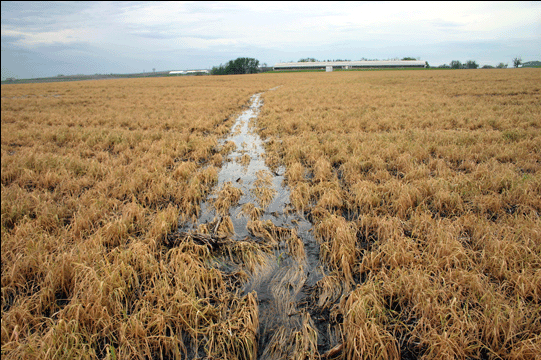The recent mid-April storm reminded many southern Iowa farmers why there is never a good time for tillage – even after a dry winter and the warmest March on record.

|
Up to eight inches of rain, along with strong winds and tornadoes, hit southern Iowa on April 14 causing property and cropland damage. In many cases, crop inputs like corn seed and fertilizer washed away.
In Montgomery County, District Conservationist Tom Burkhiser with USDA’s Natural Resources Conservation Service (NRCS) says a 20,000-acre area with mostly unprotected fields sustained soil losses in excess of 20 tons per acre.
Alan Lange, NRCS district conservationist in Adair County, reported similar damage there. He says approximately 25,000 cropland acres lost more than 20 tons of soil per acre.
Burkhiser said there is a definite difference in the amount of erosion between tilled and untilled fields. “In fields where tillage was done, sheet and rill erosion is severe,” he said. “Corn stalks and bean stubble from fields left undisturbed protected the soil well. The biggest problem from this storm is ephemeral gully erosion.”
Cover Crops – Secret to Heavy Rain Protection
Farmers like Steve Berger of Wellman in Washington County, who planted cover crops in the fall, went mostly unscathed. Berger says three inches of rain fell that evening on his farm. When the sun came up the next morning, however, the cereal rye cover crop that he sprayed with a kill-shot just two weeks prior protected the soil from erosion.
Berger is a 30-year no-tiller. He added a cereal rye cover crop to his rotation 10 years ago. “Cover crops help to reduce soil loss and improve soil health,” he said. “A lot of ground in the area has been worked up as corn is planted, so there were several worked fields with significant soil erosion.”
Typically, it takes more than one conservation practice to protect the soil during heavy rains, especially when the rains hit like they did April 14, says Barb Stewart, state agronomist for NRCS in Des Moines. She says residue management practices like no-till, along with erosion control practices such as terraces, contour buffer strips, and grassed waterways provide good protection against soil erosion. She says optimal erosion control can be attained by combining those practices with cover crops.
“Cover crops supply another blanket of protection against the impact of raindrops,” said Stewart, “and cover crop roots help hold the soil in place.”
Pete Hobson, who no-till farms in Pottawattamie County, grew a rye grass cover crop in corn residue last fall and just recently sprayed it in preparation for planting. He says those fields are free of erosion following more than three inches of rain on April 14 and more than an inch a week prior.
Hobson said he benefited most from drilling wheat into a field with soybean stubble in areas most susceptible to ephemeral gullies. “I sprayed the wheat with RoundUp® the Monday before and it still kept those gully-prone areas from washing,” said Hobson. “For me, it’s less about the cover and more about the fibrous root systems that cover crops provide that help hold the soil in place.”
During heavy rains cover crops provide an unintended benefit, too – keeping crop residue out of culverts. “We saw some problems with corn stalks and bean stubble plugging culverts,” said Burkhiser.
After months of below average rainfall, many farmers are now dealing with saturated fields from the weekend storm. Stewart says cover crops can help in the drying process, as well. “Cover crop roots provide good soil structure which allows water to infiltrate,” says Stewart. “Tilled soil leaves you with a muddy mess following heavy rains. It takes a long time to dry them out, and leaves you with a hard crust on top.”
“It really comes down to, ‘What is the soil worth to you?’” said Stewart. “Is the cost of planting a cover crop worth keeping the soil on your farm?"






Post a comment
Report Abusive Comment